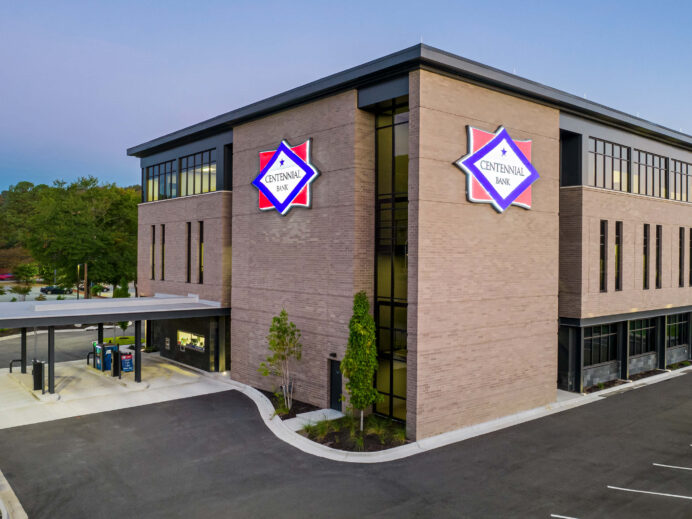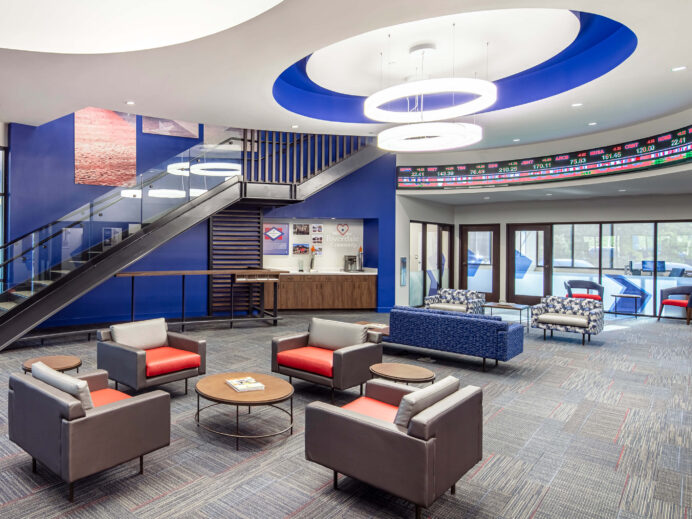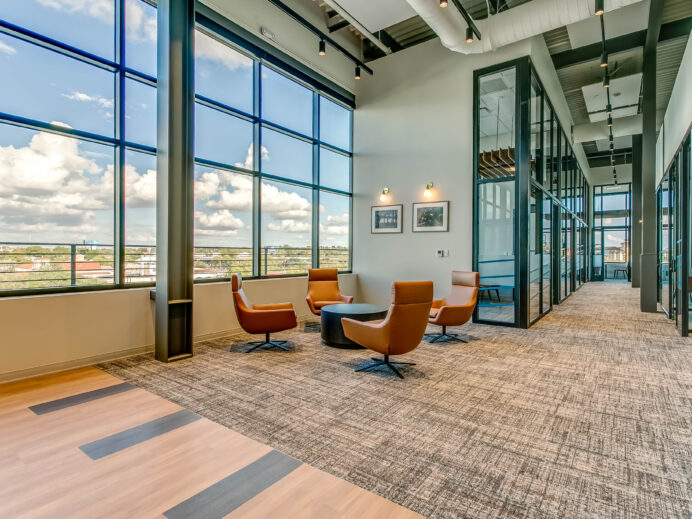A Q&A on the evolution of branch interiors with Amanda Pouliot & Monique Rodrigues, Design Directors of Adrenaline’s Retail Experience Design Studio
As transactions continue to migrate toward digital, retail banking design must evolve to meet new consumer expectations for experiences that are focused on essential guidance, not efficient processes. That means branch design must also break from its transaction-oriented past and move toward a more human-centered future. “How banks deepen relationships is by rethinking branch purpose and reorienting their branches toward an evolving North Star,” according to Believe in Banking’s exploration of branch banking. “These experiences are typically centered less around the transaction and more around the interaction.”
Consumers have made it clear that they prefer financial guidance in the branch environment, with 70% of customers reporting they want a branch close-by for access to expertise and advice when they need it. This preference for the branch for consultation holds true for every generational cohort. “Across all age demographics and geographic locations, people still value the branch,” according to data trends reporting from Believe in Banking. “They want them in their neighborhoods, so that they feel connected and protected,” with the majority of consumers turning to branches to solve more complex financial challenges.
But how does the move toward becoming a consultation hub come to life? For the best thinking and trends in branch design and construction, we spoke with retail design and experience experts Amanda Pouliot and Monique Rodrigues. They have led the design process for some truly beautiful branch transformations at Adrenaline – from prototypes to flagships, and beyond. Here’s what they have to say about today’s top trends in bank branch design and construction.
As branches are updated with advisory space in mind, how are they effectively moving away from transactions inside the branch?
Amanda: What I’ve been seeing is that the overall focus of branches is becoming much less about the teller pod, or teller area in general, really. It’s still a function of the space, but more of a secondary focus. The emphasis is shifting more to spaces that support those consultative engagements, those in-person interactions. Because when we think about it, people can do so much of their banking transactions from their phone.
So, what is going to be that draw that makes somebody want to come inside a branch? It’s putting that opportunity for conversation at the forefront of the visual experience of the space, as well as the function. I think what that means tactically is we’re seeing less dedicated office space and space assigned to one specific function like transactions. Instead, we are seeing those spaces becoming a little bit more flexible, allowing staff and customers or members to select the right environment for whatever it is they have chosen to come into the branch for.
Monique: Amanda hit the nail on the head. From a volume standpoint, we’re seeing transactions decreasing about 5% per year in any branch network. That’s due to the digital experience making things more convenient. COVID built on the digital trend and really accelerated the transition away from that transaction zone and the teller pod. From an institutional perspective, bank executives really have to think about how a physical network still plays a role in banking when so much can be done within a mobile platform.
Banks and credit unions really started to think about not only how they help their customers, but if people aren’t coming in for easy transactions, what are they really using the branch for? It’s more about that advisory type of consultation. Banks are transitioning to how they can begin to deepen and strengthen relationships with customers and how they go with them on a journey throughout their lives. We know that nobody’s journey is really linear, so banks can really help people in a lot of different ways.
The resurgence of the drive-up experience is something that came out of COVID as well. Prior to 2020, we typically saw declining rates of drive-ups, but since the pandemic, that has been somewhat of a popular choice as a lot of consumers became accustomed using the drive-up for transactions, and never really resumed to reentering the branch for that service. So, it seems that using the drive-up for transactions has kind of stayed around for now. I’ll be interested to see how that evolves over the next few years.
Along with drive-ups, are ITMs becoming more popular?
Monique: A lot of banks are using the ITM technology in a transitionary way. They’re implementing machines that can still function as an ATM, so as a customer looks at the screen, they can choose to make an ATM transaction or they can connect to a virtual teller – the machines allow for both functions. As banks are replacing ATMs in their networks, they’re putting in the ITM capabilities, even if they don’t use them now. When they’re ready, it’s just software they would need to update. This allows them to prepare for the future within the lifespan of that ATM, so in five to ten years they can transition to an ITM.
Amanda: The concept of remote service offered through an ITM that doesn’t need to be a drive-up attached to the building – with a staff member inside servicing it – is really opening up a lot more flexibility for designers. If the experience inside the branch does not need to be tethered to servicing a drive-up, we’re able to truly reimagine that branch purpose on the inside. With an ITM, the drive-up can be on that same plot of land as the building or elsewhere in town, where the brand wants to spread their presence out a bit. It’s allowing the focus of the branch to almost double down on that human interaction, which is why we want people to ultimately get out of their car and come inside.
That brings up the idea of future proofing, where banks can make changes now that set them up for the future, even if they’re not getting there right now. How do they make progress towards their future North Star?
Amanda: As Monique pointed out, banks are investing in hardware and technology that has flexibility built in. Conceptually that also plays out across the entire space, whether it’s architecture, millwork or graphic design. Some examples in millwork include the accommodation for standard ways of processing cash handling now, like cash drawers, that could be converted to a file drawer or a storage cabinet in the future. We’ve designed an intentionally convertible space within the millwork to accept something like a TCR or a more advanced cash processing solution later. So, we’re designing millwork that’s somewhat modular, and therefore, flexible and multipurpose.
Architecturally, we’re creating spaces that foster human interaction and looking at ways that to provide for that in a private setting or even a semi-private setting. We’re leaving space a little bit more open with a little less hard-wall construction. As purpose continues to evolve, we have the flexibility for change. In branch communications, we’re seeing a big use of digital messaging, so it’s easier to update or customize when a bank is pushing out a new campaign. Overall, banks are future proofing by building in flexibility across the retail environment.
Monique: The design and construction industries overall are also responding to that need for flexibility. We work with a lot of storefront type of furniture systems where many of their products have been developed to allow more flexible wall units that have electrical and data built in instead of hard walls. That allows banks to more easily take down a wall when they need to and potentially transition offices into a conference room, for example.
A lot of branch locations have been oversized. As banks are trying to move to the future as they are relocating or building new branches, they’re rightsizing them. They’re also moving to this omnichannel approach where they have different types of formats from a traditional branch to maybe a micro branch, so they’re being much more strategic around the appropriate amount of space to meet consumer demand.
As we’re designing, we’re also being challenged about how to use the space. In some instances we look at lobby spaces and turn them into a place where bankers can have a consultative session with first-time home buyers, for example. So, we use a lot of movable, light and multi-purpose furniture. Building in that flexibility is key to helping banks future proof, so their branches don’t feel so old so quickly. It’s one of the things that is really going to help them iterate, so they know their branch can always feel modern and fresh, even as things change.
Learn more about how Adrenaline can help your bank or credit union keep up with the latest trends in branch design and construction.
Adrenaline is an end-to-end brand experience company serving the financial industry. We move brands and businesses ahead by delivering on every aspect of their experience across digital and physical channels, from strategy through implementation. Our multi-disciplinary team works with leadership to advise on purpose, position, culture, and retail growth strategies. We create brands people love and engage audiences from employees to customers with story-led design and insights-driven marketing; and we design and build transformative brand experiences across branch networks, leading the construction and implementation of physical spaces that drive business advantage and make the brand experience real. Get in touch today.







